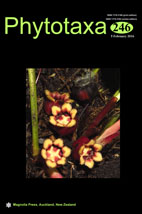Abstract
Syneilesis Maximowicz (1859: 165) (Asteraceae: Senecioneae) is a small genus of seven species distributed mainly in China, Korea, and Japan (Chen & Nordenstam 2011). All its species are perennial herbs with 2 or 3 palmatisect stem leaves and a corymbose or paniculate synflorescence composed of several to many discoid capitula. The genus differs from its putative closest allies, including Miricacalia Kitamura (1936: 214), Parasenecio Smith & Small (1922: 93) and Sinacalia Robinson & Brettell (1977: 274), primarily by having a single cotyledon (Maximowicz 1859; Kitamura 1934) and a base chromosome number of x = 26 (Koyama 1961; Takeshita 1961; Arano 1964).

